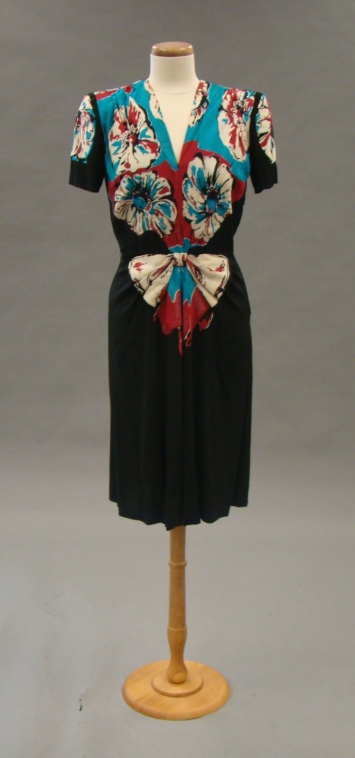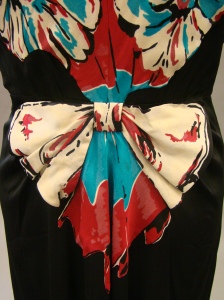Only a few more days to see Women for Women: Female Fashion Designers! The exhibition celebrates the work of well-known women designers, as well as lesser-known talents.
Falling into that latter category is Jo Copeland (1899 – 1982). The daughter of an immigrant shirtwaist salesman, Copeland was almost born to the industry. Yet, the clothing creations she produced beginning in the 1920s and 1930s were a cut above much of the fashion manufactured by the New York garment industry.

Fig. 1: Jo Copeland, dress, rayon, 1943. Textiles & Clothing Museum, 998.19.4
Her designs, like the designer herself, were sophisticated and refined. Press accounts consistently held up the same chic example as characteristic of the Copeland aesthetic: the tailored day to evening suit, worn sans blouse.[1] Her daughter, Lois Gould, later wrote that Copeland “would have quibbled” with that description: rather it was “a dress with a jacket so artfully tailored, so subtly supported by fine silk underpinnings, that it did the work of suit, blouse, slip and bra.”[2]
As Gould recounted in the memoir, Mommy Dressing, being the daughter of a fashion icon was not always easy. Copeland was a glamorous person and a gifted fashion designer, but as a mother, she was often distant. Gould wrote: “I knew she went ‘downtown’ every day. She was always late for her own parties because she was busy ‘downtown’ at her ‘place.’”[3] Her “place” was the design workrooms of Pattullo Modes, where Copeland spent the better part of her career, and where she eventually became a partner, and the company was rechristened Pattullo-Jo Copeland.[4]
Frequently remarked upon was Jo Copeland’s design process. The designer reportedly draped a preliminary design on her own body, using a mirror as her guide.[5] By Gould’s account, Copeland did sometimes drape and pin and adjust her designs on fit models before final sketches were made. Yet, Gould remembered her mother’s more novel way of working as well; in lieu of a model, “my mother then began to drape the cloth against her own body. This way; no, that.”[6]

Fig. 2: Detail of Jo Copeland, dress, rayon, 1943. Textiles & Clothing Museum, 998.19.4.
Copeland’s deft and creative use of fabric was another recurrent theme in her work. In 1948, she spoke with New York Times fashion editor Virginia Pope, admiring new printed fabrics that were “startling in effect” and which would “blend with the silhouette of the dress to make designing easier.”[7] Yet, fabrics that “blended” into the design of a dress appear to have been an element of her work even prior to the praise she lavished on postwar fabrics. The dress in figs. 1 & 2, believed to be from 1943, features a floral print that tapers seamlessly to the garment’s narrow waist and its jaunty bow detail. The print of the dress in figs. 3 & 4 is also unique, and somewhat fanciful, seeming to pertain to a theme of exploration, depicting large sailing ships, pilgrims, Native Americans, and sailors.
Copeland believed in an American point-of-view in fashion design. In 1965, she criticized New York designers for their reliance on the Parisian industry for style direction, telling the New York Times, “the greatest thing that has happened to me was my divorce from Paris,” which reportedly took place almost two decades earlier.[8]
She clung to her elegant aesthetic well into the 1960s, when miniskirts and body-baring styles were the becoming the rage. Critical of the hyper-revealing garments, Jo Copeland wrote an editorial piece for United Press International, advocating instead the “half-revealing, half concealing… successful formula”; it was the formula she abided by “even at the risk of being considered square.”[9] Whether consumers considered her designs “square” is unclear, but for one reason or another, Pattullo Modes closed its doors in 1970.
Jennifer Farley Gordon
We’re away for the winter break from December 19, 2015 – January 10, 2016. Look for new posts and a new TCM exhibition in the New Year!
[1] Susan Chira, “Jo Copeland, a Fashion Designer Noted for Two-Piece Suit, is Dead,” New York Times, March 21, 1982, A39; “Jo Copeland Services Held,” Women’s Wear Daily, March 22, 1982, 27.
[2] Lois Gould, “Fashion Pioneer,” New York Times, August 25, 1996, SMA62.
[3] Lois Gould, Mommy Dressing: A Love Story, After a Fashion (New York: Doubleday, 1998), 7.
[4] “Pattullo Firm Now Pattullo-Jo Copeland,” Women’s Wear Daily, May 31, 1949, 47.
[5] Isadore Barmash, “Dissent Voiced on Paris Designs: Jo Copeland Urges End to Dependence on French Couture,” New York Times, March 19, 1965, 49; Susan Chira, “Jo Copeland, a Fashion Designer Noted for Two-Piece Suit, is Dead,” New York Times, March 21, 1982, A39.
[6] Lois Gould, Mommy Dressing: A Love Story, After a Fashion (New York: Doubleday, 1998), 10.
[7] Virginia Pope, “Big Strides in Style Development Forecast by Jo Copeland, Blotta,” New York Times, January 5, 1948, 22.
[8] Isadore Barmash, “Dissent Voiced on Paris Designs: Jo Copeland Urges End to Dependence on French Couture,” New York Times, March 19, 1965, 49.
[9] Jo Copeland, “Designing Lady Pokes Holes in Trend to Peek-a-Boo Togs,” Chicago Defender, February 16, 1966, 22.

